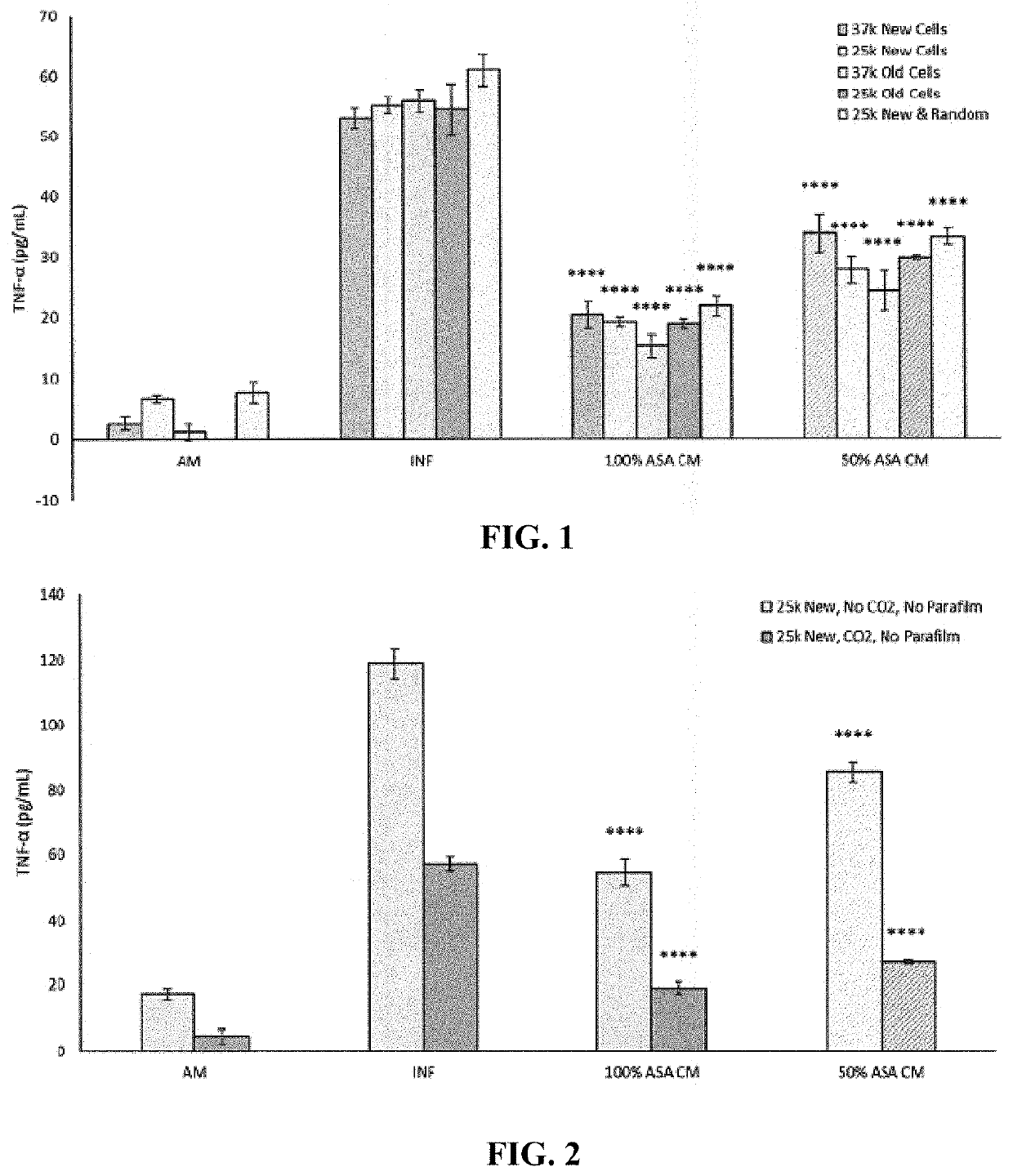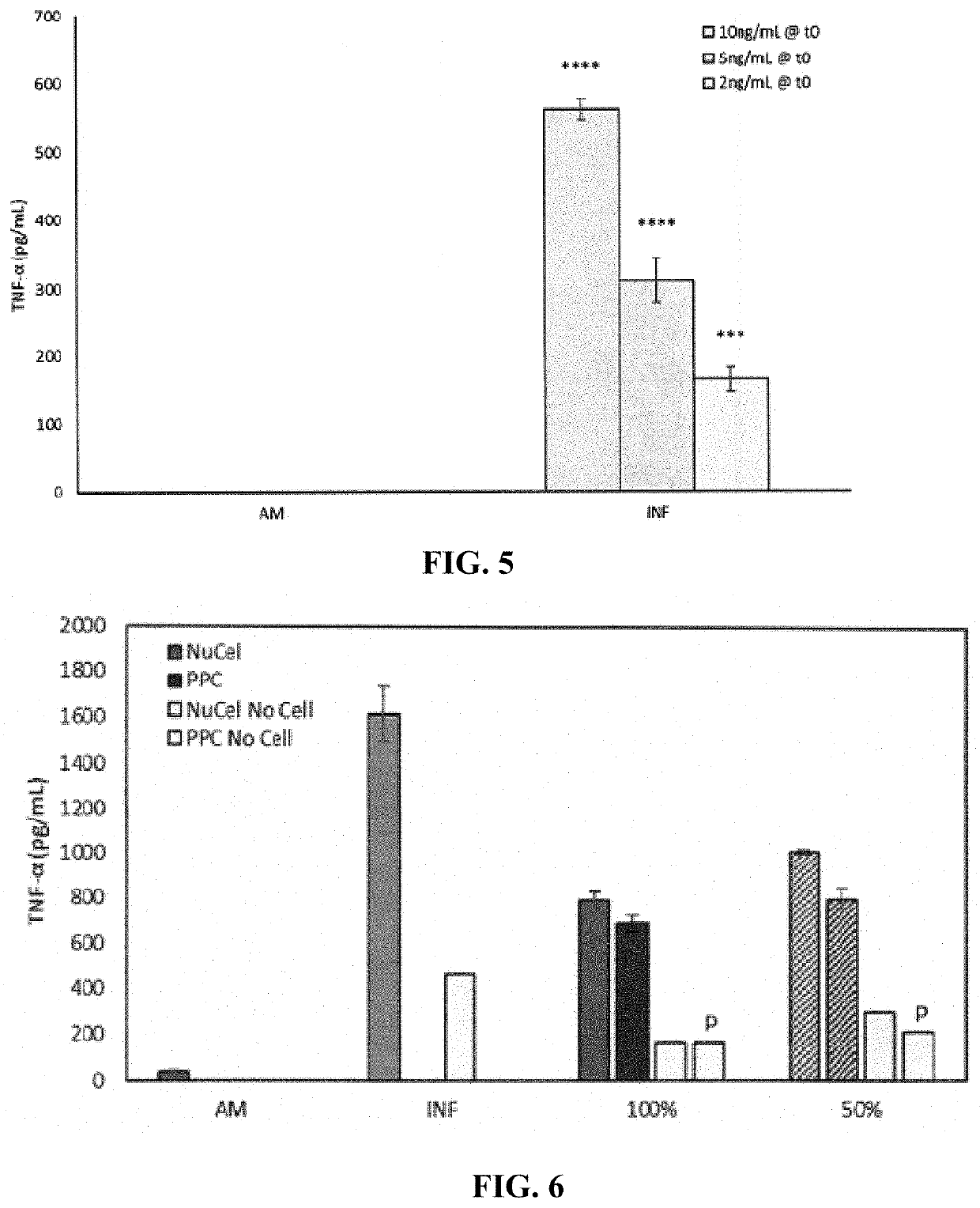Methods, kits and compositions for characterizing an Anti-inflammatory response of a product
a technology of anti-inflammatory response and kit, applied in the field of degenerative diseases, can solve the problems of increased water content and loss of tensile strength in the cartilage matrix as the lesion progresses, long-term exposure to elevated inflammatory cytokine levels can be detrimental to bone healing, and the process is not per
- Summary
- Abstract
- Description
- Claims
- Application Information
AI Technical Summary
Benefits of technology
Problems solved by technology
Method used
Image
Examples
example 1
[0175]The effects of high passage (old cells) and low passage (new cells) at cell densities of 37,000 cells / well and 25,000 cells / well were examined. In this example, the term high passage refers to cells that have been continually passaged (>10 times) and may have reached confluency or over-confluency in the flask during continual maintenance. The term low passage refers to cells that have been thawed and passaged between about 1 and 5 times before use in the assays, and these cells were carefully managed during passaging to avoid cells reaching >90% confluency between passages.
[0176]SW982 were seeded at a density of 25,000 cells / well or 37,000 cells / well in 800 μL of growth media in a 12 well plate and allowed to attach overnight, with 7 plates prepared in total. Four plates had SW982 cells at passage 30 (“new cells”) at 25,000 cells / well, one plate had SW982 cells at passage 30 (“new cells”) at 37,000 cells / well, one plate had SW982 cells at passage 37 at 37,000 cells / well (“old ...
example 2
[0183]In this example, the effects of dosing SW982 cells with varying amounts of TNF-α at 10 ng / mL, 5 ng / mL, and 2 ng / mL is examined, while keeping the concentration of IL-1β constant at 1 ng / mL. SW982 cells at passage 29 were seeded at a density of 25,000 cells / well in 800 μL of growth media in four 12 well plates and allowed to attach overnight in an incubator without CO2. Growth media was Leibowitz's L-15 medium (HyClone, Chicago, Ill.) supplemented with 10% fetal bovine serum (FBS).
[0184]Following attachment for approximately 24±4 hours, cells were primed for 72 hours with assay media (AM) alone, or assay media with activating factor. Assay media was 50% (v / v) complete growth medium in basal media (Leibowitz's L-15). The activating factor comprised 1 ng / mL of IL-1β (Invitrogen catalog number RIL1BI, lot number U1287721A, Carlsbad, Calif.) and either 10 ng / mL, 5 ng / mL, or 2 ng / mL of TNF-α (Millipore catalog number GF023, lot number 2946036, Burlington, Mass.). After 72 hours, all...
example 3
[0189]The repeatability of the potency assay was investigated using a pooled positive control (PPC) and an ASA (NuCel®) CM from a commercial lot (lot number 184670903). Additionally, a dose curve was run to assess responses to different percentages of ASA CM. The PPC was created using NuCel commercial lots to make 5 batches of 30 vials each, ensuring that PPC CM was generated with roughly equal contributions from the various batches.
[0190]A flask of SW982 cells at passage 31 (passage+3 from thaw, 100% confluent) was used and seeded on one full 12-well plate and 8 wells of a second 12-well plate at 25,000 cells / well in growth media. For the dose curve, two additional 12-well plates were seeded at this cell density. All plates were placed into an incubator at 37° C. without CO2. Growth media was Leibowitz's L-15 medium (HyClone, Chicago, Ill.) supplemented with 10% fetal bovine serum (FBS).
[0191]Following overnight attachment, one well from each of the AM and activating factor groups ...
PUM
| Property | Measurement | Unit |
|---|---|---|
| time | aaaaa | aaaaa |
| concentration | aaaaa | aaaaa |
| concentration | aaaaa | aaaaa |
Abstract
Description
Claims
Application Information
 Login to View More
Login to View More - R&D
- Intellectual Property
- Life Sciences
- Materials
- Tech Scout
- Unparalleled Data Quality
- Higher Quality Content
- 60% Fewer Hallucinations
Browse by: Latest US Patents, China's latest patents, Technical Efficacy Thesaurus, Application Domain, Technology Topic, Popular Technical Reports.
© 2025 PatSnap. All rights reserved.Legal|Privacy policy|Modern Slavery Act Transparency Statement|Sitemap|About US| Contact US: help@patsnap.com



